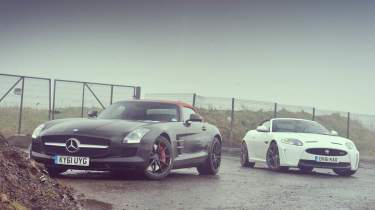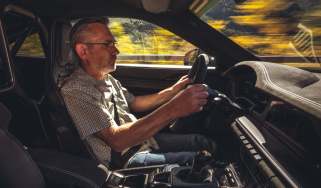Jaguar XKR-S Convertible vs Mercedes SLS AMG Roadster
The Jaguar XKR-S Convertible and Mercedes SLS AMG Roadster help recreate a famous motorsport rivalry that dates back to 1955
As our SLS Roadster rushes through the darkness of a deserted North Wales, chasing the tail-lights of a new Jaguar XKR-S Cabriolet in a race to catch our overnight ferry, I’m wondering just what we’re going to find on the other side of the Irish Sea. In 1955, German ace Wolfgang ‘Taffy’ von Trips would have been similarly preocuppied. It was his first time with the factory Mercedes squad and he’d been given a 300 SLR Carrera coupe to drive from Germany to Ireland so that he could get used to the layout of the car he would be racing – one of three open-topped 300 SLRs competing in the Golden Jubilee running of the RAC Tourist Trophy.
Mercedes was in severe need of points in the World Sportscar Championship. On paper its drivers would face stiff competition over the seven hours and 84 laps from three factory Ferrari 857 Monzas and a trio of factory Aston DB3Ss, but in fact it was a lone Jaguar D-type that was to prove their main rival…
The terrible events at Le Mans three months earlier can’t have been far from von Trips’ thoughts as he drove, but he must also have been wondering about the fearsomely fast and yet frighteningly narrow 7.5 miles of lanes that made up the Dundrod circuit. And if, like photographer Dean Smith sitting next to me, he wasn’t a good sailor then he wouldn’t have been relishing the prospect of bobbing around on the water for several hours trying not to throw up.
High winds are whipping across most of the UK this January evening, consequently stirring up a decent swell on the Irish Sea, so to limit our time afloat (and ensure a good drive along the A5!) I’ve booked us (that’s Dean, Andy Wallace and me) onto the shorter Holyhead to Dublin Stena Line route instead of the more obvious Liverpool to Belfast one. Nonetheless, the loud exclamation of ‘Daddy, it’s just like Titanic!’ from a small child just after we’ve left dock doesn’t go down well with a pale-faced Smith.
The following morning, safely on dry land and after an untroubled couple of hours’ drive north on empty dual-carriageway to Belfast, we head west and go in search of the Dundrod circuit. It’s still used today for the Ulster GP motorbike race, so I’m hoping it might be easier to find than some of the long-lost circuits we’ve gone in search of in the past.
A bit of grubby black-and-white kerbing at a junction is the first indication that we’re in the right area. Then, protruding from a bank, there’s a rudimentary raised wooden platform that I assume must be a marshals’ post. Soon after, a thin, painted yellow line appears randomly about two-thirds of the way across the road and disappears off round a corner. We follow what I’m hoping is a pit-lane line and thankfully some Armco materialises on one side of the road. On the other is a structure with a tribute on it to Joey Dunlop (who won a record 24 Ulster GP motorbike races). It’s probably a grandstand, but might just as easily be there to keep the rain off farm machinery as spectators.
The start/finish straight is a rather desolate place once we’ve switched off the two V8s, with only the gentle pattering of rain on corrugated iron interrupting the mid-morning peace and quiet. Back in 1955, at 10.30am on September 17, there would have been a veritable thronging hubbub as all 49 cars lined up for the start. The noise of an eclectic mix of race engines being warmed, mingling with the excited chatter in the full two-storey grandstand is hard to imagine. Incredibly, over 60,000 spectators were spread out round the circuit.
Stirling Moss was always an expert at the short sprint and leap into the cockpit of the Le Mans start, and it was no surprise that it was his no. 10 Mercedes that roared past in the lead after the first lap. Peter Collins in his Aston had got a terrible start and was away dead last, but Mike Hawthorn in the Jaguar D-type was second and in hot pursuit of Moss.
I try to keep a straight face as I ask Wallace what it was like when he had to do proper Le Mans starts, but he doesn’t rise to it and just grins and calls me a cheeky git. So, with him playing the diminutive Moss to my lanky Hawthorn, we take a rather more leisurely stroll across to the SLS and XKR-S before putting their respective roofs down (the Merc’s taking a lot less time) and turning the heated seats on (the Jag’s warming more comfortingly).
The slightly downhill start/finish straight kinks right into an arrow-straight stretch of road known as ‘The Flying Kilo’, where the bikes reach 190mph. Then it’s a fast, blind kink left through a crossroads before a long right-hander hugging a high grass bank, which is matched almost immediately by a similarly fast left-hander with an equally high and view-obscuring bank. At this point the original circuit went right and over a stone bridge, but the ‘modern’ track goes down to a junction and on to a long uphill straight where it rejoins the original route.
You can imagine the cars in ’55 working hard and battling against the gradient as the road swept up to the track’s highest point. Unsurprisingly, the 542bhp Jaguar and 563bhp Mercedes dispatch it with complete disdain. Both feel absurdly fast, but the Jaguar struggles to lay down all of its power on the wet tarmac, zizzing its rear tyres on the change from second to third gear, so losing a little ground every time to the SLS’s brutish and almost baffling levels of traction.
The top of the hill has a blind right-hander that crests on its apex (unweighting the back of the car just when you want to get on the power) before falling roller coaster-like downhill towards a crest known as Deer’s Leap. Even at our relatively sedate road speeds there doesn’t feel like there’s much time to look at the wonderful view across towards Lough Neagh, but with the throttle wide open in a race it must have felt like a terrifying plummet as the cars gathered speed with gravity at their backs. At least they had good brakes in the ’50s…
With this in mind it’s perhaps not surprising that it was here, on the second lap of the race, that a large cloud of smoke was seen to rise. No one is entirely sure what happened, but it seems Vicomte Henri de Barry in a road-going 300 SL was holding the middle of the road, rather baulking those behind. As Jim Mayers came over the crest at Deer’s Leap at about 130mph in his Cooper T39, he was presented with a blue Mercedes-shaped moving chicane and swerved left and then right to try to overtake before losing control and smashing into a stone gatepost. Killed instantly, he and the now flaming car ricocheted back into the road, covering it with burning fuel from the split tank.
Peter Jopp described coming over the crest alongside Bill Smith with all four wheels off the ground and seeing the carnage ahead. Jopp squeezed his disc-braked Lotus through, albeit collecting a photographer scrambling for the bank on the way, but Smith’s Connaught couldn’t avoid the blazing wreckage of Mayer’s car and dug into the bank, throwing him out and killing him. In the end, seven cars were involved. It’s hard to imagine such a scene of carnage in such a tranquil setting. But then it also seems utterly incredible that the race wasn’t stopped…
After Deer’s Leap there’s a hideous downhill, gently curving braking zone before you peel right into a side road that funnels into an overarching avenue of beech trees. This is where convertibles come into their own. I love the gullwing doors of the SLS coupe – they’re a big part of its appeal. And the wings and vents of the XKR-S don’t sit quite so well on the convertible as they do on the fixed-roof version. But what you lose in looks and door theatre, you gain in nape-prickling open-air concert atmosphere. Through the acoustically accentuating tunnel of trees, the two cars have quite distinctive soundtracks. The Jaguar has a real snarl to it, with a slightly rough edge and just the occasional hint of supercharger whine. The Mercedes sounds almost like a massive V-twin at idle before developing a rich, fast-spinning growl as the revs rise. The SLS is mellower in sound than the XK but there’s a deep quality to it that is intoxicating. And then you lift off at high revs and the crackles spilling into the cockpit on the overrun are pure aural nirvana.
As the trees recede, we turn right again at a junction – away from the tiny collection of houses that make up Dundrod itself – then there’s a tightish left hugging some more black-and-white kerbing at Ireland’s Corner. From here for the next mile and a bit it’s difficult to get your head around racing on this circuit because it is just so fast. There are corners, but they’re really, really fast and mostly really, really unsighted. We can’t get near the speeds it would be possible to hit if the roads were closed, and at times we’re almost 100mph shy of the speeds Bruce Anstey, Guy Martin et al would be travelling, sorry, racing at on the bikes.
At these sorts of speeds a mechanical failure is a terrifying prospect, but that’s exactly what happened to Moss in ’55. His right rear tyre threw a tread at Wheeler’s Corner, throwing him into the bank. Incredibly, he limped back to the pits where the mechanics cut away the mangled bodywork and John Fitch took over behind the wheel. Meanwhile, Hawthorn had already pitted the D-type, handing over to Ulsterman Desmond Titterington, who inherited the lead.
Titterington might not be a familiar name, but had he not retired so young many think he could have become Northern Ireland’s first world champion. Hawthorn was apparently dumbstruck with his young teammate’s speed around the Dundrod circuit, and with the Jaguar pulling out a breezy ten seconds a lap on Fitch’s 300 SLR, the imposing Mercedes team boss, Alfred Neubauer, was forced to call the American into the pits after only six laps and put Moss back into the car just as rain started to fall.
By now, Vicomte de Barry had been black-flagged for his part in the second-lap crash, and although he vehemently denied any wrongdoing there were additional reports from stewards that he had also been spotted smoking in the car later in the race! Whatever, he couldn’t be blamed for the events at Tornagrough. It’s a very tricky left-hander that comes after a decent straight, but the braking area is slightly uphill so you can lean on the pedal a fraction later. The corner goes on longer than you expect and crests gently halfway through, making it even trickier. Richard Mainwaring, a 24-year-old farm manager from Sussex, had got it all wrong in his Elva, possibly caught out by the moistening track conditions. The car overturned and burst into flames when it hit the bank. Three drivers had been killed before half the race was run.
The weather isn’t exactly fantastic today, and as we head downhill towards the Lindsay Hairpin (passing the first junction that the motorbikes now use and taking the much tighter second junction 50m further on) the Jaguar feels nervy on the wet tarmac. The steering is very light, and although it’s accurate the lack of resistance when you turn makes the front tyres feel remote and hard to trust. Talking to Andy Wallace later, he makes the point that lateral grip is in fact good, but once into the corner you’re constantly on edge because of the lack of longitudinal grip. Just when you want to feed in the throttle and drive through the corner, you’re hesitant because you sense that the rear wheels could spin up so easily and pitch you sideways so quickly that you’ll have to catch it on instinct. Of course, out of the first-gear hairpin, it’s just fun (and easy) to hold a big, long slide.
It’s gradually downhill now for approximately a mile, all the way to the pit straight again, but there are some tricky corners along the way. The cambers frequently seem to be of the ‘off’ variety and I find the speeds really hard to judge even after several runs through, with the feeling usually being that you are coming in too quickly and yet somehow nearly always exiting too slowly as well.
Thankfully the SLS is one of those cars that feels rewarding whatever speed you’re missing apexes at. Remarkably, the roadster doesn’t seem to have lost any of the coupe’s rigidity, and any poseurs expecting a boulevard cruiser will be shocked by the firmness of the ride. Sitting so far back in the chassis, you can really feel how the rear wheels are gripping and slipping (mostly gripping) underneath you, so you tend to drive the SLS by pouring the long bonnet into the corner and then concentrating on steering the subtly pliable rear end with the throttle. There’s a worry with so much traction that the edge of grip might be sudden and fairly final when you find it, but it’s actually beautifully controllable for such a big car. It’s a driving style that, bizarrely, probably wouldn’t have been unfamiliar to the drivers in the race all those years ago.
By lap 56, Moss had reeled in Titterington, who pitted and handed the D-type back to the bow-tied Hawthorn, who in turn regained the lead when Moss pitted. The period footage (both a colour film and a black-and-white Pathé report are viewable on the internet) shows just how fast and how closely the Jaguar and Mercedes were brushing the banks compared with the others, both cars in near constant, inch-perfect four-wheel drifts. Ultimately, though, there was to be no stopping Stirling on what was his 26th birthday. As the rain started to fall even harder, the Mercedes tucked into the Jaguar’s watery slipstream on the start/finish straight and then hammered past.
Hawthorn still had the small matter of keeping both the legendary Fangio and the young von Trips behind in the other two Mercedes, and he was pushing hard, slipping briefly into a ditch at one point but recovering in time to hold on to second place. A certain Colin Chapman sadly retired towards the end of the race with a broken oil pipe, having been leading the 2-litre class and the Index of Performance. Then, with everything seemingly settled and just two laps remaining, the D-type’s straight-six engine seized, spinning Hawthorn into a side road just up from the finish line. Apparently, in his typically insouciant style, he wandered back to the pits as though nothing had really happened. Moments later, Moss crossed the finish line to win his third TT, heading an all-Mercedes podium.
The modern Jaguar and Mercedes aren’t really in direct competition because the two cars are separated by over £70,000. However, if I had to pick one to go for a fast lap of the circuit in then it would be the Mercedes. The Jaguar would be huge amounts of fun in the dry, when the tarmac’s resistance would give a bit more feel to the steering, and it would be as hilariously drifty as a lot of historic machinery as well as breathtakingly fast, but in the wet it doesn’t give you enough confidence. It’s also fair to say that you do notice the price gap in the XK’s slightly dated-looking interior and more protracted roof mechanism. But, just like its ancestor, I do love the way it looks from front three-quarters.
The SLS might not look as dramatic as a mid-engined 458 or Gallardo, but it feels every bit as heavy-hitting and ludicrously fast. It’s even quite practical, and I can forgive the perennially slightly disappointing manual mode on the twin-clutch gearbox (it doesn’t respond with enough alacrity when you use the paddles) because the automatic shifts in Sport Plus are so spookily good. Mix in that glorious, deep soundtrack and the beautiful front-engined rear-drive balance and I think you’ve got one of the most desirable and enjoyable supercars on sale today.
The 1955 RAC Tourist Trophy was the last one to be held at Dundrod, and the last time the TT was to take place on any road circuit. The understandable reaction after the race was that it was simply too dangerous. This somehow makes it even more incredible that motorbikes are still racing at Dundrod today, the lap record now standing at a jaw-dropping 133mph average, making it faster even than the Isle of Man TT course. As a place to visit it’s curious, because like so many road circuits it’s not glamorous, there’s not much that screams ‘track’, and sometimes it’s hard to even find the route. But when you know the history behind the roads, they come alive in your mind and I love that.
I did actually manage to take the SLS for a slightly faster lap of the circuit when the roads were quiet and I won’t forget it for a while. Roof down, windows down, hunkered behind the windscreen, V8 noise rising and falling as passing banks, hedges and houses all acted as fleeting sounding boards. Speed was tempered at times by the ghosts of Mayers, Smith and Mainwaring, yet on the better-sighted corners and straights I couldn’t help but try to invoke just a little bit of the bravery of the straight-armed Moss, the local boy Titterington and the dapper Hawthorn…
Hold on tight for a lap of Dundrod in the Jaguar XKR-S...




